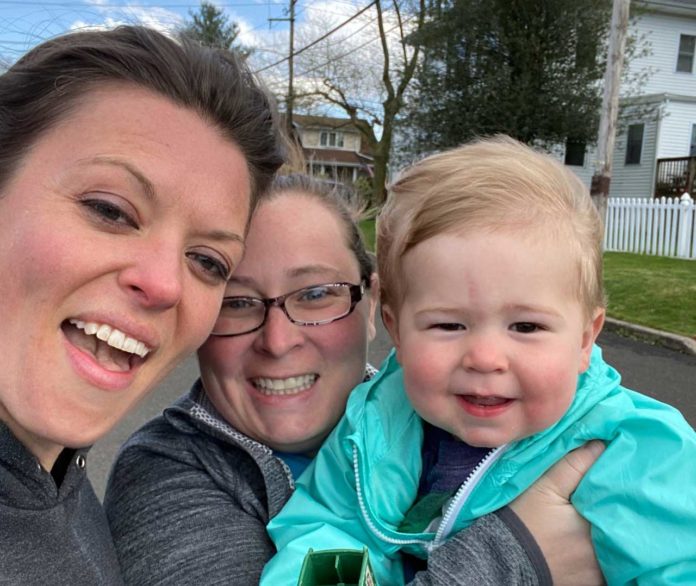Let me start this by saying to all teachers, daycare employees, caregivers and anyone else who devotes their time to molding the minds of little ones: Thank you. And you deserve a damn raise.
As of today, we’re on day 63 of quarantining at home with Jackson. While I’ve had to shift to becoming a remote employee, like millions of other Americans, I’ve also had to learn how to become a stay-at-home parent. That doesn’t just mean changing more diapers and being the one to fight with Jackson to eat his lunch: I had to transform into a teacher, practically overnight.
Thankfully, Jackson’s not at the age where he’s learning fractions or writing book reports, but he has a fair amount of formal structure in place at daycare; in fact, we’ve taken many of our cues for his development—when to shift to solid food, when we should abandon bottles—from daycare. We probably should have been doing more active teaching before now; Jackson’s at the age where he’s an absolute sponge—he soaks up anything and everything you say and do—so he’s ripe for learning. And, as of March 16, we were on our own to figure out what that meant.
Circle Time — Or Something Like That
I knew from day one of this stay-at-home thing that Jackson and I would need structure — he would be rammy and bored if all day was just a free-for-all, and I wouldn’t be able to get a stitch of work done. A few days into quarantine, our daycare center sent out the loose structure they use for the day: snacks, outdoor playtime, art, Circle Time. I had already started doing most of that list except for the last; so I jokingly suggested to Jackson, “Should we do Circle Time?” And he ran to the middle of our living room rug, sat down, folded his hands and looked up expectantly. OK. Now what?
In March, my repertoire of educational nursery rhymes was near nil — so I sat on the rug with Jackson and tried to reach into the treasure trove of my childhood memories to pull out some awkward renditions of “Itsy, Bitsy Spider” and “Twinkle Twinkle, Little Star.” Jackson side-eyed me and eventually got up and walked away.
But we came back to it day after day and eventually got into a rhythm — that, admittedly, involved YouTube videos (we try really hard to avoid any and all screen time, but I allowed a few minutes for clips that include singing, counting, colors, etc.). Thankfully, after a few weeks, our daycare teachers took a video of the actual Circle Time routine from home — and, with a newly acquired hand-me-down easel from a neighbor, I now spend about 10 minutes each morning going through the days of the week, months, weather, shapes, numbers and ABCs (and still finish it up with a few minutes of help from YouTube!).
We also bought a few cheap packs of early learning flash cards from Amazon and, after Circle and video time, we go through them and break out Jackson’s ABC sets to reinforce it all (though, by that time, he’s usually itching to go back to crashing his trucks into each other).
Outside the ABCs
ABCs seem like the natural place to start teaching a toddler, but I’m learning there’s so much more that can help expand his vocabulary — along with shape his emotional and behavioral development — and a lot of these “teaching” moments are developing naturally.
With A LOT more one-on-one time now with Jackson, my tolerance for his acting out has plummeted, so I’ve redoubled on our previously half-hearted attempts to utilize “Time Out.” Jackson now has a dedicated chair in our dining room where he sits for about a minute-and-a-half (concurrent with his age) any time he is egregiously disobedient. Lately, he’s been in a hitting phase when he gets frustrated, so he’s a frequent visitor to Time-Out (five times before 8 a.m. earlier this week, in fact!). Sticking to a routine at home has also helped with teaching behavior and our parental authority; having the same repetitive structure each day helps Jackson learn when it’s time to put away his toys, that he can’t go out for a walk until getting on shoes or that he won’t get dessert unless he eats most of his lunch (this one’s still a big struggle!).
Part of our daily routine includes chore time from around 7 a.m.-8 a.m. — and Jackson surprisingly loves it. He helps me unload the dishwasher (I quickly scoop up all the knives first), and excitedly drops all of the rest of the utensils into their drawer. I was amazed when he picked up the lid to a pan and put it away right in the spot he’s seen me do it. He’s equally eager to help out with loading the washer and dryer (though it can take an hour, as he places items in one by one) and has even taken to scooping out the dog’s food into her bowl each morning — so we’re already building future chore lists for when he gets older.
Teaching Can Be Fun — But Constant
Sometimes, Jackson just doesn’t have the attention span for sitting before his easel, and I’ve had to teach myself that teaching doesn’t always have to be formal. Just like the notion that the classroom isn’t always the most conducive setting for learning, I’ve also tried to incorporate more hands-on, interactive ways to illustrate the concepts a nearly 2-year-old should be understanding.
Jackson has a set of large foam ABCs in a variety of colors and, after several days of using them to point out colors and sing the ABCs — and him getting progressively bored of that — I decided to switch it up by introducing an activity he loves: jumping. I made a big circle in our living room and grouped the letters according to color, then had both of us stand on a color and yell out a new one to jump to. He got maybe one of out every five colors right, but it at least kept him engaged.
Like many other homebound folks, walks have become the highpoint of our day. We usually do a few with Jackson in his stroller (so I can work on my phone as I push him) and then a few where he walks. While the exercise and fresh air are great for us both, walking is also an opportunity for him to see the many objects on his flash cards in person. My neighbors must think I’m nuts because I walk along in constant conversation with a babbling toddler: “Yeah, that’s a stick.” “Hey, look at that tree!” “There’s a doggie.” When he’s on foot, Jackson loves collecting sticks and rocks, and I try to show him how things vary in size and texture. Lately, we’ve been heading to the nearby main road and parking it on the corner so he can see all the trucks (anything on wheels is a truck to him), another opportunity to point out colors, noises and shapes.
But I’ve found that being in constant teacher mode can be quite draining. Especially in our current hyper-stressful time. I think many parents, us included, are feeling undue pressure to be everything at once — employee, spouse, parent and, now, teacher. Before the pandemic, parents of course were responsible for the teaching of their youngsters, but not nearly as the sole source — now, however, the expectations have skyrocketed — as has the stress.
I’m trying to temper that by reminding myself how much Jackson has grown and learned in the last two months. Since being home, Jackson has said a bevy of new words: ball, Mom and Momma (used interchangeably for us both!), owl, geese, eyes, keys, hat, jacket, tractor, no, doctor, pasta, Joe (his grandfather!), love you — and more every day. He’s discovered he loves trash trucks, can throw a ball with the best of them, identifies songs within just a few of the first notes and knows all of his stuffed animals by name. He’s learning discipline, responsibility, how to be bored and how to challenge himself. Most of all, he’s learning he’s in a household filled with love — we may all be at the end of our quarantine rope, but we’re in this together, and that’s the best lesson we can ever teach Jackson.

